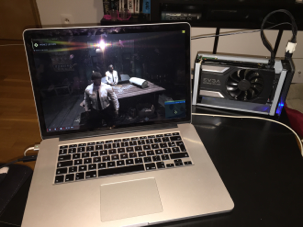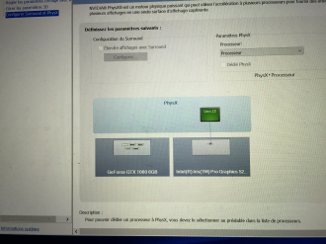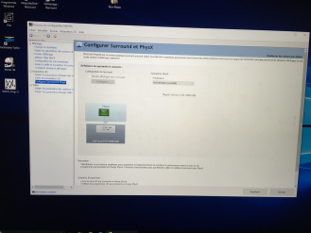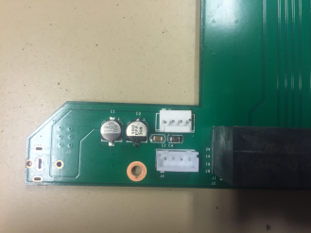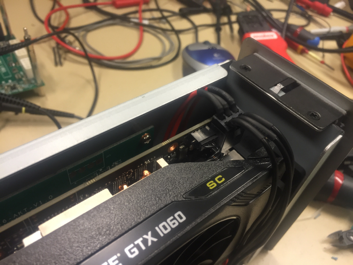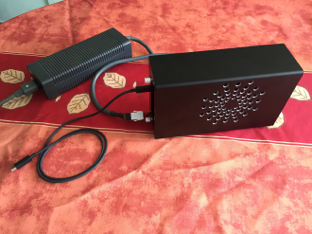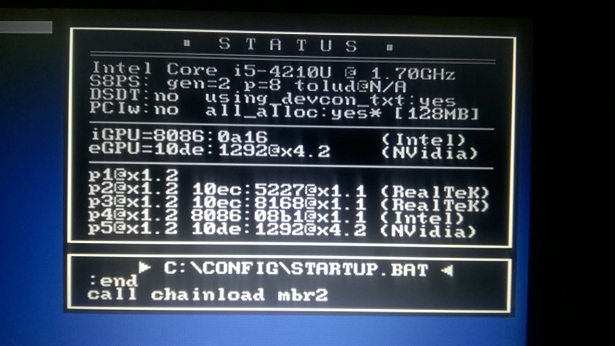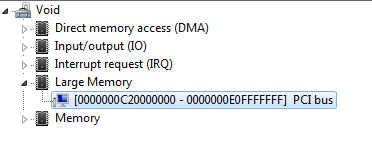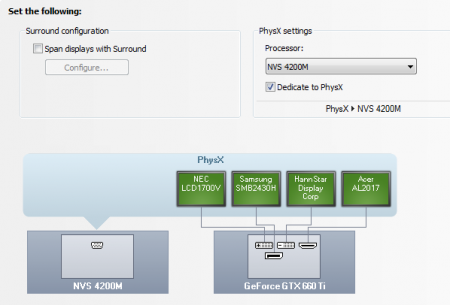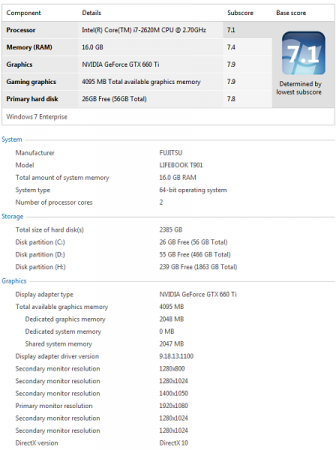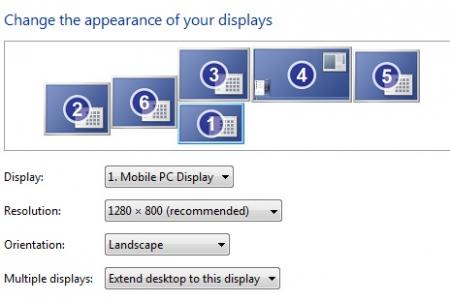Search the Community
Showing results for tags 'dgpu'.
-
hi guys , i am new here can any one tell me how to disable igpu & and dgpu from lenovo y510p . i want to use gtx 1080 with GDC beast my laptop detect graphics card but it showing code43 error .so i cant use it so may dgpu disable can help . my bios still default(not moded )
- 2 replies
-
- exp gdc beast gtx 1080
- leovo y510p
-
(and 2 more)
Tagged with:
-
Hey guys, Let me introduce you my eGPU setup, realized on a 2013 15" retina Macbook Pro, model equipped with a dedicated GT 750M. I am using an Akitio Thunder2 PCIe enclosure and a EVGA Geforce GTX 1060 SC 6Gb. I wanted to use both internal and external display on my Mac. I was looking for information during weeks before buying it and wasn’t really sure if it would work as I wanted to. Many people are convinced that using the internal screen is impossible or way more complicated if the Mac has a dedicated GPU. I spend a whole week formatting and testing, using UEFI, BIOS, considering going back to Windows 7 (not for long)… I finally used Windows 10 UEFI, the programs rEFInd and GPU-switch and nothing else ! No need for an HDMI headless ghost or any program to spoof the number of screens. I made a video to show you the whole installation process, I hope that it will help: My GF did the voice acting as I wasn't convinced by my own If you prefer a text-based tutorial, here are the different steps: 1) Installation of Windows 10 in UEFI mode On the 2013 retina Macbook Pro, the SSD is a PCIe model. This seems related to the UEFI mode used by default when using the Boot camp assistant. If you don’t want to use it or are using another model of Macbook, you can follow this excellent tutorial to force the UEFI mode: http://fgimian.github.io/blog/2016/03/12/installing-windows-10-on-a-mac-without-bootcamp/ You just need to create a conventional partition and convert your table partition from “hybrid” to “protective”. By doing this, Windows will see a GPT disk instead of MBR. You just need to boot your USB drive on EFI mode. Once Windows is properly installed with the correct Macbook drivers (another reason to prefer the boot camp assistant), you need to go back to Mac OS. 2) Installing rEFInd rEFInd is a boot manager tool, like rEFIt or GRUB. Its first advantage is the ability to choose the OS without the need to press a key at startup. And the real reason why we are using it is to spoof the computer to allow Windows seeing the entire installed hardware. You can install refind from this link: http://www.rodsbooks.com/refind/ Then you need to activate this spoof ability by opening a terminal and typing these two commands: sudo mkdir /Volumes/efi sudo mount -t msdos /dev/disk0s1 /Volumes/efi Now, you can see your EFI partition in your Finder. Go to EFI/EFI/refind and open the file refind.conf with textedit. Search for the “spoof OS version” and remove the comment symbol # Reboot your computer and choose Windows on the rEFInd screen. Open your device manager, you’ll see your iGPU (intel iris pro graphics 5200) and dGPU (Geforce GT 750M) 3) gpu-switch GPU-switch can be downloaded from there: https://github.com/0xbb/gpu-switch Download the windows version, available in the description (direct link : https://github.com/0xbb/gpu-switch/releases/download/v0/gpu-switch-windows.zip ) Install Microsoft C++ redistributable (not sure which version do the trick, I’ve installed each version in x64 and x86 just to be sure) open the file integrated.bat with administrator rights, you should see the word “success” 4) GPU driver installation Not sure if this step is necessary but I’ve removed the dGPU driver before installing nVidia GeForce experience. The program DDU (Display Driver Uninstaller) is perfect for that. You can download it using this link: http://www.guru3d.com/files-details/display-driver-uninstaller-download.html Choose to uninstall and shutdown the computer, as you will install a new hardware indeed When your computer is off, plug the power supply to your eGPU, press the computer power button, wait for the chime and the rEFInd screen to appear, then plug your eGPU to the Macbook and launch Windows. If rEFInd is stucked, hold the power button until the computer is off. You should now see three graphics cards in the device manager, two of them not recognized at this point. Install nVidia GeForce experience and the latest nVidia driver. The GPU list will be updated at the end of the installation process. Re-launch GPU-switch and reboot. You don’t need to unplug the eGPU when rebooting. Now, your eGPU should have an error code 12, with unsufficient resources available. Just right clic on the dGPU (GT 750M) and disable it. Re-launch gpu-switch just to be sure (integrated.bat) and reboot. Just a last step and you’ll good to go Right click on the nVidia icon in your systray and open the configuration panel. Go to PhysX and set it to automatic instead of processor, like on this picture: That’s it, you can now launch your games on the internal screen or using an external monitor To switch between both, just plug the display on the eGPU and use the shortcut Win + P (Cmd + P on a Mac keyboard) to toggle between both screens. You can also duplicate them, it works, but don’t expect any kind of good performances doing this Now, the most important part, to avoid screwing your configuration: every time you go back to Mac OS, Windows will switch to the dedicated GPU (maybe also when turning off the computer, I’m not sure). For this reason, always re-enable the GT 750M before turning off the computer! Otherwise, you’ll get a black screen at Windows startup. Just follow this procedure when you want to use your eGPU: - Use gpu-switch to set the integrated GPU as primary - Disable the dGPU from the device manager - Turn off your computer or reboot - When you see the reEFInd screen, plug your eGPU and launch Windows - Play you favorite video game or launch your intensive GPU application (there are two schools) - Re-enable your dGPU from the device manager - Turn off your computer - Unplug your eGPU Now, some advices based on my little experience: If your end up with a black screen, you can restore Windows to a previous restauration point or remove the display driver. If you really can’t boot windows, using Parallels Desktop, you can boot your Windows partition from a virtual machine, then remove the display driver. At first, I was experiencing a game crash and the GPU fan running at max speed, when launching any sort of game. This issue was caused by the power supply connection, using an Xbox 360 S adapter with too thin wires These wires caused a voltage drop when consuming the 100W needed when playing a game (against 15W on Windows) About the electrical connections, here are a few pictures I’ve added a connector on the free PCB footprint to avoid soldering wires on the board. The cables are 0,75mm2 section and fits perfectly the original jack hole. About the PCIe power connector at the top of the graphic card, I had to cut it with a Dremel to fit the enclosure. You can find specific (and pretty expensive) cables on Ebay if you don’t want to modify one. For the ventilation, a colleague helped me cutting holes in front of the fan. I’m not sure to keep this solution, as some games make it very noisy. Let me know if this tutorial or the video did help you. Don't hesitate to ask for support if you want to do the same setup. Some websites are pretty discouraging about the concept of eGPU, the whole process is not pretty user-friendly but I'm happy to see that there is an active community growing each year !
- 3 replies
-
- 2013
- retina macbook pro
-
(and 7 more)
Tagged with:
-
Hello everyone, I am a newbie in this forum and I've known about eGpu for just a few days. So i want to ask you some questions. I have an HP Elitebook 8570p and this is my specs : Intel core i5-3320m VGA: AMD HD 7570m I am planning to use an EXP GDC beast 8.0 and there are 2 options i am wondering : radeon r9 380 and gtx 970. I like r9 380 more because it's cheaper, but someone says it's hard to set up an AMD card for a laptop which also have AMD dGPU . IN the other hand,a GTx is easier to set up and have better performance. SO which one should i buy ? Another question : As I know a core I5 CPU always have integrated card Intel HD 4000 on it, but when I check in the device manager there's only dGPU Radeon 7570m. Is it possible for me to use an EGPU? Sorry for my English . Please help me and thanks in advance
-
Someone can Help me to configure my DIY for eGPU?? My Notebook: Dell vostro 5470, Dedicated card: 740m Don't start when connected to eGPU My version of BIOS is A12
-
Hi there, lots of useful info on here! Still I need to ask a few questions as my setup isn't quite working! I've a 2012 rMBP on El Capitan 10.11.2 and I used the automate_eGPU.sh script to quickly sort out the modification of files and installation of NVIDIA web drivers. I'm testing it with an NVIDIA GTS450 which is connected via a Sonnet Echo Pro and PE4C 3.0. SW1 is set to 2 (PERST# delay 9.8sec), SW2 to 1 (CLK no delay). It's picked up fine in OS X and I can drive an external monitor with it no problem. However, it doesn't appear to be doing any rendering - all the legwork is still being done by the internal GT650M!!! It shows each screen as being driven by the GT650M in About This Mac, and testing with games seems to corroborate this. What gives? I can't find any examples online of other people who've had this problem (at least in OS X). The GTS450 is correctly identified in System Information. A second question... I know there isn't a way to get the output on the internal LCD on Windows on this Macbook due to it having a dGPU and Apple's rubbish firmware, but is that the case in OS X? The Intel HD4000 is accessible there, does that mean I could funnel the graphics back to the internal LCD or is it just impossible on all counts?
-
Hi everyone, I've been using external GTX970 for several months with a external monitor. My setup is: GTX970, Macbook Pro 2014 w/ 750m. The issue is that I am currently trying to save space and use internal screen instead. I've read several threads in tech inferno no matter they gave a successful solution or not. The steps I have tried are: 1.Install reFind and run apple_set_os to get Intel Driver 2.Run Integrated.bat downloaded from GitHub 3. Connect eGPU and reboot. Now it has 3 GPU recognized (750m,5200, GTX970 with error message) 4. I disabled GT750m,run integrated.bat again and reboot. 5.Now it has 5200 and GTX970, but the 5200 is running the internal screen and I cannot open Nvdia preference since it says I do not have a Nvdia product. What should I do? At least I make it look like correct by having GTX970 and 5200 both available (and 750m disabled). But it looks like 970 are taking care of a virtual external monitor as I can guess. By the way, every reboot process I've been using comes with the apple_set_os. I am not sure it is the correct process.
-
Hey guys, I just bought an eGPU Adapter for my Medion Akoya Laptop. It has an ATI dGPU and i attached a Nvidia eGPU to it. It works great so far. But i can't seem to get the internal display working. I mean the internal display works but i guess the dGPU still processes the internal Display. Is there a way to get the eGPU process the internal display?
-
HI, I'm trying to get my egpu going on windows (for the time being I don't care about OS X), and I can't barely get started. Akitio + Evga 1070 I read many guides but I still don't get it. Right off the bat the Thunderbolt or Basic Display Adaptor doesn't even show up on Windows Device Manager. I think I read somewhere that Windows needs to boot with the Intel graphics not the AMD and in order for that to happen I need to mess with the EFI to make sure the Windows boots with the Intel and not AMD? If that is the case, i couldn't find any instructions on how to do that properly. I really appreciate any input or help! Thanks
-
I have a problem with setting 1.3. when i disable my dGPU, it stopped. not freeze but didn't do any progression. so i did another one, demoting my dGPU and when i demote my dGPU, it didn't go to main menu... Do i need usb boot? If i have to,how do i make usb bootable 'DIY eGPU setting 1.3'??
-
Hi everyone. I have a problem and i hope someone can help me. First of all i give u some information about my system: Notebook: MSI GE60 0nd i7 3630qm gtx 660m Samsung ssd ……. Bios: latest custom Bios Version (10F) from Svet (For turning off the dgpu ) OS: Windows 10 64bit Nvidia drive 364.72 External Stuff: Power Supply be quit 530W Nvidia GTX 560 Ti 448 EXP GDC V8.0 with mPCI-E Standard So lets start: My problem is that when i run benchmarks or games. Only the igpu is loading. The egpu stays at 0% My egpu is full recognized by my notebook. I see the name and also the clock oft he egpu. Sometimes when i start the game. the clock from the egpu goes from 741 MHZ to 51 MHZ. I do not why … :-S. I also set the physics process to the egpu and the 3d settings to nvidia high performanceprocessor, but without success. P.S The external display is also not responsing. BR cano
-
Please ask for support in the main DSDT Override or DIY eGPU Experiences Thread. I have been out of the eGPU realm for too long to provide adequate support. Here is a guide to performing a DSDT override with hopefully less misery, and setting up your computer to have your iGPU, dGPU, and eGPU working at the same time! Oh boy this is going to be fun. This is my system specs (Fujitsu T901): i7-2620M 16GB RAM NVS 4200M GTX 660 Ti Windows 7 Enterprise x64 Now it begins.. Disconnect your eGPU until I say so. If you can, you should perform a DSDT override. The method shown in the official thread was really hard at How to perform a DSDT override: Now for the fun part........ Disconnect your eGPU Uninstall ALL (ALL MEANS ALL) (dGPU included!!!) Nvidia drivers (keep the Intel graphics driver) Use Driver Sweeper and check all the Nvidia options, run, reboot, turn off computer -- don't install the driver for the dGPU yet Connect eGPU and go to Setup 1.x Set your eGPU port to G2 (assuming your have an adapter that supports G2, and your computer as well - if not, then skip setting the port to G2) dGPU off 32-bitA compaction for iGPU eGPU chainload to your OS Windows may yell at you to reboot due to hardware changes, don't quite yet Check device manager, you might (I did) have error 43 Attempt to install the latest Nvidia drivers for you eGPU -- still don't install drivers for your dGPU If your lucky, it will install, if not: shutdown/reboot Setup 1.x do the same as before (dGPU off and such) Attempt to install the Nvidia drivers again for your eGPU After a few hours of fiddling around, you should get them installed (keep your dGPU off this whole time) ONLY AFTER YOU GET YOUR eGPU DRIVERS INSTALLED!! (and as such, error 12 in device manager) Go to Setup 1.x Set port G2 on your eGPU port (again, if you support G2) 32-bitA compaction for iGPU dGPU eGPU (or choose 36-bit if you performed a DSDT override) chainload You will probably get the reboot due to new devices again, but before you do, check device manager Might have a generic VGA device or something instead of the NVS 4200M Attempt to install the drivers for you dGPU now If no luck, reboot and do the same Setup 1.x as before (with dGPU on) Attempt to install dGPU drivers again Reboot after you get your dGPU drivers installed Keep the same Setup 1.x method If your lucky you should have your iGPU dGPU and eGPU show up fine in device manager. You can go to the Nvidia control panel and dedicate your dGPU as your PhysX processor, it works really well. (If you play stuff that supports PhysX and have an at least somewhat useful dGPU) ------------------------------------ I hope this helps. ^ over 20 hrs of fiddling around well spent ;-; ------------------------------------ HOW TO: Update drivers (probably): Note: You can check your driver version for both your eGPU and dGPU in the System Information dialogue box under 'Help' in the NVIDIA Control Panel (you can even check your Bus here too (PCI Express x1 Gen2 as shown for my eGPU). Results::::: iGPU + dGPU + eGPU dGPU PhysX dedicated: WEI: ALL THE MONITORS (and all different resolutions too ): Weeee~~~~~~~~~~~~~~ Check out a video here:
- 95 replies
-
- 12
-



